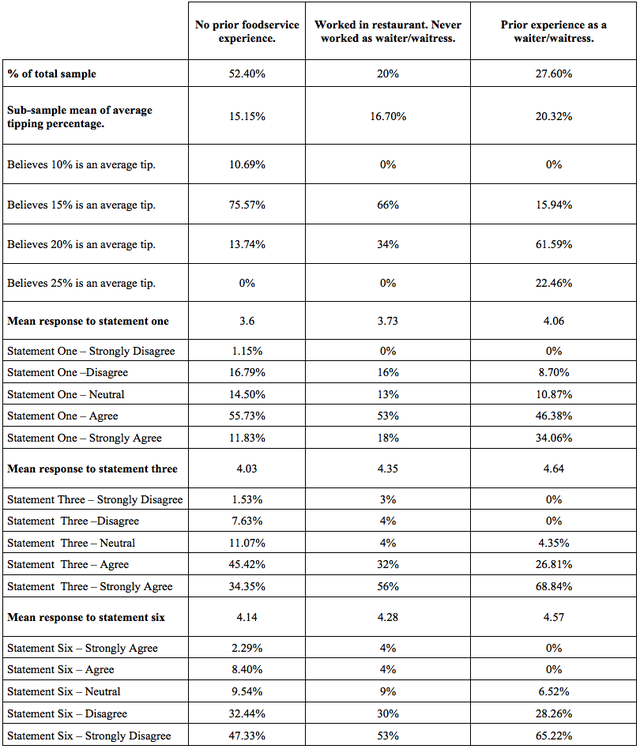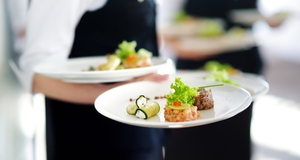How Much Should I Tip? Restaurant Tipping Behavior as a Result of Prior Foodservice Experience
By
2014, Vol. 6 No. 10 | pg. 2/2 | « MethodologyData was obtained through in person surveys conducted with 500 undergraduate students at the University of Maryland, College Park. The study surveyed 316 caucasian students, 53 black or African American students, 95 Asian students and 36 students who considered themselves to be some other race. Within this sample, 316 of the participants were female and 184 were male. The participants were asked to answer a series of questions meant to retrieve some unambiguous data. They were asked whether they were an undergraduate student at the University of Maryland, what their gender was, what ethnicity they most identified with, whether they had worked at a restaurant, and whether they had worked as a waiter/waitress. Any surveys containing blank responses were discarded. The sample population of this survey was limited to students at the University of Maryland who were obtaining their undergraduate degree. The majority of students obtaining undergraduate degrees are under the age of 25 without full-time jobs. Any survey in which the participant answered “No” to the question “Are you an undergraduate student at the University of Maryland College Park?” was discarded. The participants were also asked to indicate which of the given tip values were their idea of an average tipping percentage. The values ranged from 5 to 25% and were broken into 5-point increments.Participants were asked to rate five statements regarding dining out. Responses were assigned values based on a 5-point Likert scale (ranging from “Strongly Disagree” [1] to “Strongly Agree” [5]). The statements students evaluated were as follows:
Statement six (“When dining out, it is not important to tip the waiter/waitresses well”) was reversed from the original statement to reduce the presence of acquiescent responding. This response was also coded backwards (“Strongly Agree” [1] and “Strongly Disagree” [5]). Surveys in which participants responded with either a 4 or a 5 on statements three (“Waiters/waitresses deserve to be tipped”) and six (“When dining out, it is not important to tip the waiter/waitresses well”) were discarded as “yeah-sayers,” people who tend to agree with everything (Stangor, 2007). A number of devices were employed to counter reactivity in the student’s responses. Statements two (“Dining out is a positive experience”), four (“I prefer dining out to dining in”), and five (“I prefer to dine out more than once a month”), which do not explicity have to do with a person’s tipping behavior, were included in the Likert scale to disguise what the self-report measure was designed to test. The survey also implored respondents to answer honestly (c.f. Stangor, 2007). To determine whether having a previous job as a waiter/waitress lead to differences in tipping behavior, the responses of each sub-sample population were compared to the other sub-sample populations. The original sample population was divided into three sub-sample populations: Students with no prior experience in the foodservice industriy (either as a waiter/waitress or in any other capacity), students who worked in a restaurant but not as waiter/waitress, and students who had worked as waiter/waitress. Only the responses from the questions regarding work experience, average tipping percentage, and statements one (“I think of myself as an above average tipper”), three (“Waiters/waitresses deserve to be tipped”), and six (“When dining out, it is not important to tip the waiter/waitresses well”) were compared because they have the most significance in relation to tipping behavior. Sample responses and sample mean comparisons were used to compare the data. ResultsA comparison of the results obtained from the three sub-sample populations found that those who had never had a job in a restaurant or as a waiter/waitress had a lower average tipping rate than those with no prior foodservice experience. Additionally, those with no prior experience were more likely to indicate 10% or 15% as average tips and less likely to think that 20% was an average tip. No one without prior experience as waiter/waitress felt that 25% was an average tip. Additionally, the sub-sample mean of responses to each statement were significantly lower than those of participants who had worked in a restaurant. The group with no restaurant work experience had a lower positive response rate regarding tipping behavior and dining out than both sub-samples that had worked in restaurants. Among the two sub-samples with foodservice experience, the sub-sample of those who had worked both in a restaurant and as a waiter/waitress showed the strongest positive association with tipping. Additionally, this group had the highest percentage of its sub-sample population respond that 20% or 25% were average tipping rates. Table 1: Survey Results Discussion and ConclusionParticipants who have worked as a waiter/waitress were more likely to strongly agree that a waiter/waitress deserves a tip, that tipping is important when eating out, and that they themselves are above average tippers. This finding agrees with Lynn (2009), who found that people are more likely to tip for intrinsic reasons than self-presentational reasons. Empathy is an intrinsic value, so it makes sense that a person is more willing to help someone with whom they are able to empathize. If a person has never had a job in the restaurant business they are less likely to empathize with their server, even though they may still feel the need to tip in accordance with the broader social norm (Conlin, Lynn and O’Donoghue, 2003). On the other hand, those who can relate directly through previous personal experience as a waiter/waitress have a better understanding of how important tipping is, and as a result, are more likely to tip well. ReferencesAzar, O.H., Tobol, Y. (2008). Tipping as a Strategic Investment in Service Quality: An Optimal-Control Analysis of Repeated Interactions in the Service Industry. Southern Economic Journal 75, 246-260 Conlin, M., Lynn, M., & O’Donoghue, T. (2003). The norm of restaurant tipping. Journal of Economic Behavior & Organization, 52(3), 297-321. doi: 10/1016/S-167-2681(03)00030-1 Mealey, L. (2010), “The basics of restaurant tipping: all about dining gratuity,” available at: http//restaurants.about.com/od/customerservice/a/Tipping.htm (accessed 01 may 2014). Lynn, M. (2009). Individual difference in self-attributed motives for tipping: Antecedents, consequences, and implications. International Journal of Hospitality Management, 28(3), 432-432. doi: 10.1016/j/ijhm.2008.10.009 Lynn, M. & Williams, J. (2012). Black-white difference in beliefs about the U.S. restaurant tipping norm: Moderated by socio-economic status? International Journal of Hospitality Management, 31(3), 1033-1035. doi: 10.1016/j.ijhm.01.004 Lynn, M. & Thomas-Haysbert, C. (2003). Ethnic Differences in Tipping: Evidence, Explanations, and Implications. Journal of Applied Social Psychology, 33(8), 1747-1772. doi: 10.1111/j.1559-1816.2003.tb01973.x Stangor, C. (2011). Measures. In Research methods for the behavioral sciences (pp.76-80). Australia: Wadsworth Cengage Learning. Suggested Reading from Inquiries Journal
Inquiries Journal provides undergraduate and graduate students around the world a platform for the wide dissemination of academic work over a range of core disciplines. Representing the work of students from hundreds of institutions around the globe, Inquiries Journal's large database of academic articles is completely free. Learn more | Blog | Submit Latest in Psychology |



















